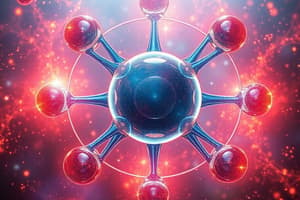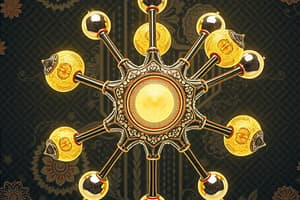Podcast
Questions and Answers
What is formed when two atoms share a pair of electrons?
What is formed when two atoms share a pair of electrons?
- Ionic bond
- Metallic bond
- Hydrogen bond
- Covalent bond (correct)
Which type of bond is characterized by the sharing of electron pairs between two atoms?
Which type of bond is characterized by the sharing of electron pairs between two atoms?
- Ionic bond
- Covalent bond (correct)
- Network bond
- Polar bond
In the context of atomic interactions, what does a covalent bond specifically refer to?
In the context of atomic interactions, what does a covalent bond specifically refer to?
- A reaction without electron interaction
- An attraction caused by charges
- A transfer of electrons
- A mutual sharing of electrons (correct)
Which of the following does NOT describe a covalent bond?
Which of the following does NOT describe a covalent bond?
Why do atoms form covalent bonds?
Why do atoms form covalent bonds?
What hybridization corresponds to carbon atoms 2 and 5?
What hybridization corresponds to carbon atoms 2 and 5?
Which carbon atom has a linear hybridization?
Which carbon atom has a linear hybridization?
What is the atomic number equivalent to in an atom?
What is the atomic number equivalent to in an atom?
What is the shape associated with sp3 hybridized carbon atoms?
What is the shape associated with sp3 hybridized carbon atoms?
Which statement is true regarding electrons in an atom?
Which statement is true regarding electrons in an atom?
In which field does organic chemistry play a crucial role?
In which field does organic chemistry play a crucial role?
Which hybridization is represented by carbon atoms 1, 3, and 4?
Which hybridization is represented by carbon atoms 1, 3, and 4?
Which carbon atom has the highest percentage of s-character?
Which carbon atom has the highest percentage of s-character?
What defines the various energy levels or electron shells in an atom?
What defines the various energy levels or electron shells in an atom?
Which element is primarily discussed in reference to atomic structure and organic compounds?
Which element is primarily discussed in reference to atomic structure and organic compounds?
What type of molecular orbital is formed when two orbitals overlap in-phase?
What type of molecular orbital is formed when two orbitals overlap in-phase?
When two orbitals overlap out-of-phase, what type of molecular orbital is created?
When two orbitals overlap out-of-phase, what type of molecular orbital is created?
Which statement is true regarding the formation of bonding molecular orbitals?
Which statement is true regarding the formation of bonding molecular orbitals?
What is a characteristic of antibonding molecular orbitals?
What is a characteristic of antibonding molecular orbitals?
Which of the following best describes the term 'in-phase overlap'?
Which of the following best describes the term 'in-phase overlap'?
What type of hybridization is present in the atom C1?
What type of hybridization is present in the atom C1?
When one of two atoms connected by a σ bond rotates about the bond axis, what happens to orbital overlap?
When one of two atoms connected by a σ bond rotates about the bond axis, what happens to orbital overlap?
Which of the following compounds has the structure corresponding to HCN?
Which of the following compounds has the structure corresponding to HCN?
What is the bond angle around atom C2?
What is the bond angle around atom C2?
Which compound contains a boron atom?
Which compound contains a boron atom?
Flashcards are hidden until you start studying
Study Notes
Atomic Structure
- The number of protons in an atom is equal to the number of electrons.
- Electrons are located in energy shells which differ in energy levels.
Carbon Atom Structure
- Carbon has four valence electrons, meaning it can form four bonds.
- The valence electrons are located in the second energy shell.
Covalent Bonding
- A covalent bond is formed when two atoms share a pair of electrons.
- The strength of the bond depends on the degree of orbital overlap.
Hybridization
- Hybridization is the mixing of atomic orbitals to form new hybrid orbitals with different shapes and properties.
- The type of hybridization observed depends on the number of bonds the atom forms.
- sp3 hybridization: Four equivalent orbitals, resulting in a tetrahedral shape with bond angles of 109.5 degrees.
- sp2 hybridization: Three equivalent orbitals, resulting in a trigonal planar shape with bond angles of 120 degrees.
- sp hybridization: Two equivalent orbitals, resulting in a linear shape with bond angles of 180 degrees.
Sigma and Pi Bonds
- A sigma bond is formed by the overlap of atomic orbitals along the internuclear axis.
- A pi bond is formed by the lateral overlap of atomic orbitals.
Molecular Orbitals
- Bonding molecular orbitals are formed by in-phase overlap of atomic orbitals.
- Antibonding molecular orbitals are formed by out-of-phase overlap of atomic orbitals.
- Sigma bonds are formed by the overlap of s orbitals, or an s orbital and a p orbital.
- Pi bonds are formed by the overlap of p orbitals.
Rotation
- Rotation around a sigma bond does not break the bond.
- Rotation around a pi bond breaks the bond.
Studying That Suits You
Use AI to generate personalized quizzes and flashcards to suit your learning preferences.




